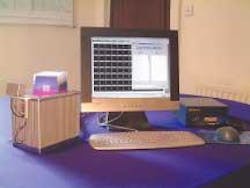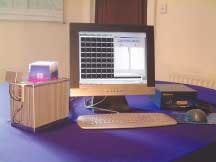Vial-scan reader automates sample identification
Every time laboratory technicians produce new biomedical samples, an identification (ID) number must be tagged to the sample and entered into a database. To avoid the errors inherent in manual entry, computer-based systems are being used to automate sample identification and tracking.
Indeed, manufacturers of liquid-handling systems offer a range of products designed to automate medical pipetting procedures. For example, needle pipettes use deep or shallow well plates that can store from 96 to 384 different combinations of solutions. During operation, each vial needs to be tracked as it is filled with reagent and moved to the next stage of the biomedical-analysis process. To do this, each vial is placed in a 12 × 8 cassette carrier and is individually stamped with a DataMatrix code so that a computer system can perform audit tracking.
Tracking every one of the 96 vials placed within a cassette carrier, however, requires that every vial must be scanned and imaged for its data code and stored data. For instance, RVSI Acuity CiMatrix (Canton, MA, USA; www.rvsi.com) built a customized and automated high-speed data reader for this purpose (see Vision Systems Design, August 2001, p. 7) for Matrix Technologies (now Apogent Discoveries; Hudson, NH; www.apogentdiscoveries.com).
ABgene (Epsom, Surrey, UK; www.abgene.com), a manufacturer of molecular biology reagents, plastic consumables, and special instruments for the life sciences market, also needed a system that could automate the identification and tracking of biological samples. The company called on Absolute Vision Ltd. (Packington Park, Meriden, UK; www.absolutevision.co.uk), an industrial systems integrator that offers a range of products connected predominantly with its 2-D DataMatrix reading systems.
Absolute Vision designed several products for marketing by ABgene as part of the company's 2-D Cypher coding system. All of Absolute Vision's products in the 2-D Cypher range read DataMatrix codes that are encapsulated on a range of plastic-compound storage tubes manufactured by ABgene. The 2-D Cypher single-tube reader can read single DataMatrix-coded tubes and consists of a desktop unit connected to a PC via a USB interface. The rack reader is used to read 96 coded tubes simultaneously. In this reader, eight CCD cameras capture eight separate images across their fields of view at the base of the vial rack.
According to Peter Greenrod, a director at Absolute Vision, the 2-D Cypher Cluster Reader is compliant with open database connectivity and object linked embedding. This reader enables integration into liquid-management systems without the need for middleware. Software used for decoding 96 DataMatrix-coded tubes simultaneously is similar to that used in the 2-D Cypher Cluster Reader software interface and supports acquisition from any TWAIN-compliant source.

